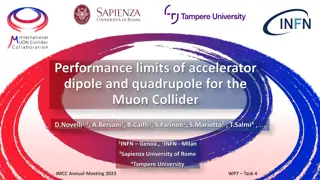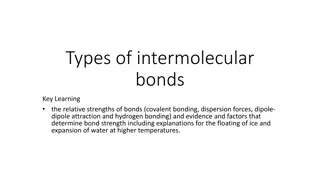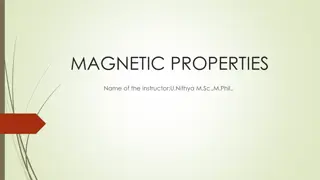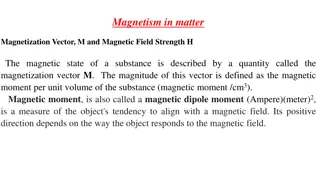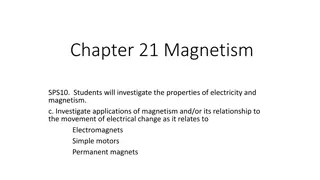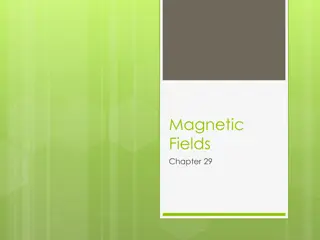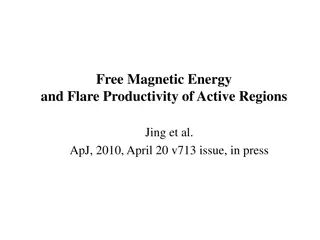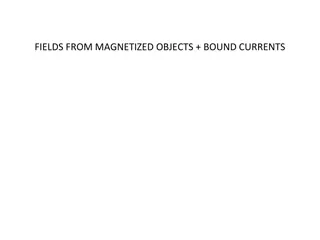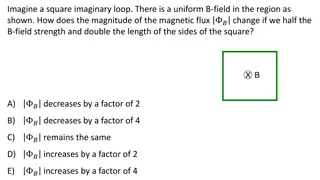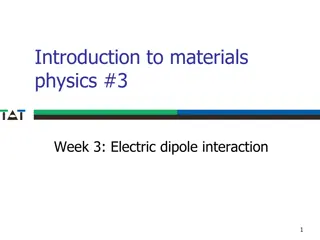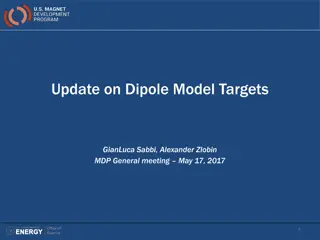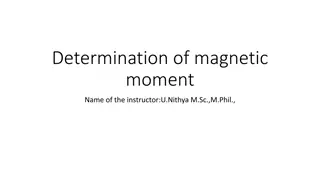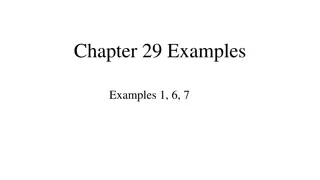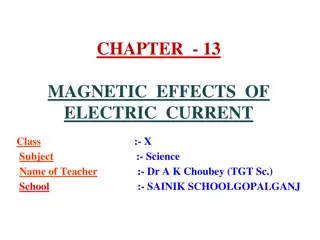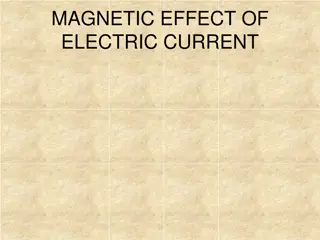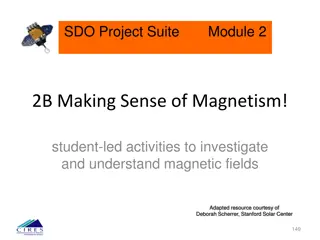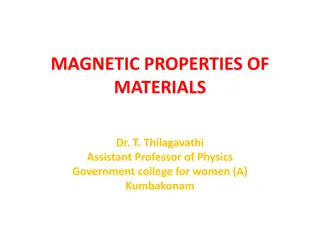Test Facility Dipole Magnetic Layout & Quench Protection Analysis
This presentation discusses the magnetic layout and preliminary quench protection analysis for the Test Facility Dipole. It covers conductor assumptions, critical current density scaling, and HEPdipo block coil designs, including graded and non-graded options. The goal is to achieve higher performance from the conductor. Further analysis and optimization are required before final selection. The presentation outlines the design review and analysis conducted on June 11, 2020.
Uploaded on Sep 15, 2024 | 0 Views
Download Presentation

Please find below an Image/Link to download the presentation.
The content on the website is provided AS IS for your information and personal use only. It may not be sold, licensed, or shared on other websites without obtaining consent from the author. Download presentation by click this link. If you encounter any issues during the download, it is possible that the publisher has removed the file from their server.
E N D
Presentation Transcript
Test Facility Dipole: Magnetic Layout and Preliminary Quench Protection Analysis D. Arbelaez, D. M. Araujo, P. Ferracin, A. Hafalia, S. Prestemon, GL. Sabbi, G. Vallone TFD Conceptual Design Review June 11, 2020
Presentation Outline Conductor assumptions Brief HEPdipo design review o Graded Design o Non-Graded Design LBNL Coil Layout Analysis o Aligned Layers (FRESCA II style) o Shifted Layers (LD style) Preliminary quench protection analysis D. Arbelaez - Magnetic Layout and Quench Protection Analysis 2 TFD CDR, June 11, 2020
Conductor Assumptions For CDR analysis conductor assumptions are based on Bruker OST RRP 108/127 1.1 mm diameter test strand (HiLumi-1.1) Analysis has also been performed with conductor assumptions from HEPdipo for comparison with CERN results Use of HiLumi-1.1 strand for CDR to have a realistic / conservative baseline but not meant to be a decision on choice of conductor at this point Further analysis and optimization is required before final selection of conductor D. Arbelaez - Magnetic Layout and Quench Protection Analysis 3 TFD CDR, June 11, 2020
Critical Current Assumptions Critical Current for 1.1 mm Diameter Wire Non-Cu Critical Current Density fNon-Cu= 0.50 fNon-Cu= 0.53 fNon-Cu= 0.46 * Lower performing conductor is used as reference for this stage of the design * Goal is to achieve higher performance from the conductor D. Arbelaez - Magnetic Layout and Quench Protection Analysis 4 TFD CDR, June 11, 2020
Critical Current Density Scaling Relation Scaling law from HEPdipo paper is used (IEEE TRANSACTIONS ON APPLIED SUPERCONDUCTIVITY, VOL. 29, NO. 5, AUGUST 2019 4001405) Fit parameters are derived for OST 108/127 1.1 mm strand using 4.2 K transport current measurements Critical Current Density Fit Parameters Parameter C0 [AT/mm2] Tc0 [K] Bc0 [T] HiLumi -1.1 223900 HEPdipo 255230 16.0 28.8 0.96 16.0 29.8 0.96 D. Arbelaez - Magnetic Layout and Quench Protection Analysis 5 TFD CDR, June 11, 2020
HEPdipo Block Coil Designs Graded Design 3 options using 2 double-layers per pole were studied [1] o Two graded designs: New cable (HF) + LD1 (LF) LD1 (HF) + MQXF-type (LF) o One non-graded design: New high-aspect-ratio Rutherford cable 26.2 1.95 mm cable 44 1.1 mm FCC strands Non- Graded Design o All 3 design options met the specs o Grading was perceived as a technological risk and was not pursued further A design option with 3 double-layers per pole was also developed [2] [1] P. Bruzzone et al., "Conceptual design of a large aperture dipole for testing of cables and insert coils at high field", IEEE Trans. Appl. Supercond., vol. 28, no. 3, 2018, Art. no. 4005505. [2] X. Sarasola et al., Magnetic and Mechanical Design of a 15-T Large Aperture Dipole Magnet for Cable Testing", IEEE Trans. Appl. Supercond., vol. 29, no. 5, 2019, Art. no. 4001405. D. Arbelaez - Magnetic Layout and Quench Protection Analysis 6 TFD CDR, June 11, 2020
HEPdipo Option 1: FCC (HF) + LD1 (LF) Operational (85% short sample) Iop 14.4 kA Bcenter test well 15.26 T Max B (HF grade) 15.69 T Max B (LF grade) 14.18 T Stored energy* 1.3 MJ/m Total Fx* +12.8 MN/m Lorentz forces Total Fy* -7.1 MN/m Total Fz* N/A *Per quadrant E. Rochepault, X. Sarasola Required cable Goals and main features: mm2 Area per quadrant 6415 Small coil volume, good margin to quench Reuse LD1 cable units, low Cu/Sc in low field Challenging mechanics, protection, fabrication HF length required** 265 m LF length required** 1001 m **Refers to the whole magnet D. Arbelaez - Magnetic Layout and Quench Protection Analysis 7 TFD CDR, June 11, 2020
HEPdipo Option 2: FCC, no grading Operational (85% short sample) Iop 13.5 kA Bcenter test well 15.06 T Max B 15.51 T Stored energy* 1.5 MJ/m Total Fx* +12.9 MN/m Lorentz forces Total Fy* -7.5 MN/m Total Fz* 1.5 MN *Per quadrant E. Rochepault, X. Sarasola Goals and main features: Required cable mm2 Area per quadrant 10494 Lower stress, easier protection No grading, simpler/faster fabrication with lower risk +60% conductor volume to achieve field/margin Increased cable UL Length required** 1489 m **Refers to the whole magnet D. Arbelaez - Magnetic Layout and Quench Protection Analysis 8 TFD CDR, June 11, 2020
Graded Design Was Not Pursued for Test Facility Dipole Magnet Advantages of Graded Design o Less conductor is required / smaller volume o Lower stored energy Disadvantages of Graded Design o More complicated mechanics / fabrication o More challenging quench protection due to high current density in low field conductor o Need additional splice for each single layer Internal splices add significant risk since they are in high field region External splices complicate geometry and fabrication also adding risk Added risk was seen as too high relative to advantages of grading Internal Splice D. Arbelaez - Magnetic Layout and Quench Protection Analysis 9 TFD CDR, June 11, 2020
Test Facility Dipole Non-Graded Magnetic Layouts HEPDipo 2-layers layouts have coils aligned on the right side (FRESCA II style) Shifted layout with spacer (LD style) was developed by Douglas Martins Araujo at CERN We have pursued two layouts at LBNL (LD and FRESCA II style) starting from Douglas designs and analysis scripts Two designs have been pursued with similar magnetic results o 16 T bore field at 85% of load line short sample (1.9 K) o Same number of total turns o 15.5 kA at 16 T for both designs o 1.8 MJ/m stored energy per quadrant o Similar field quality (<15 units for both designs) Both have similar magnetic performance and the mechanical analysis is pursued for both (see talk by G. Vallone on comparison and choice of desired layout) LD Style 46 turns 46 turns 42 turns 42 turns FRESCA II Style 50 turns 50 turns 38 turns 38 turns Spacer D. Arbelaez - Magnetic Layout and Quench Protection Analysis 10 TFD CDR, June 11, 2020
Magnetic Results for LD and FRESCA II Style Layouts LD Style Bmod[T] Operational (85% short sample) Coil 2 Layer 4 Parameter LD Style Fresca II style Units Layer 3 Iop 15.5 15.5 kA Coil 1 Layer 2 Bcenter test well 15.94 15.96 T Layer 1 Max B (coil 1) 16.46 16.44 T FRESCA II Style Bmod[T] Max B (coil 2) 16.05 16.02 T Coil 2 Layer 4 Stored energy* 1.8 1.8 MJ/m Layer 3 Total Fx*(coil 1) Total Fy* (coil 1) Total Fx* (coil 2) Total Fy* (coil 2) +6.3 +6.3 MN/m Lorentz force -2.7 -1.8 MN/m Coil 1 Layer 2 +10.0 +9.6 MN/m Layer 1 -6.9 -7.6 MN/m *Per quadrant D. Arbelaez - Magnetic Layout and Quench Protection Analysis 11 TFD CDR, June 11, 2020
Margin Analysis Test Facility Dipole Load Line Margin Analysis (1.9 K) Parameter LD Style Fresca II style Units HiLumi-1.1 strand 16 T Load Line Fraction 85.3% 85.2% - 15 T Load Line Fraction 79.7% 79.6% - 16 T Temperature Margin 3.5 3.5 K 15 T Temperature Margin 4.4 4.4 K Load Line Margin Sensitivity to Change in Ic: 1.4% increase in LL margin for 10% increase in Ic D. Arbelaez - Magnetic Layout and Quench Protection Analysis 12 TFD CDR, June 11, 2020
HEPdipo Quench Protection Analysis Results Quench protection analysis was previously done by E. Ravaioli using LEDET o Accounts for losses due to inter-filament and inter- strand coupling currents o Quench propagation Strong quench-back effect due to losses is seen for graded design For non-graded design the quench-back effect is not as strong o Calculated hot spot temperature is 120 K Graded Design Non-Graded Design D. Arbelaez - Magnetic Layout and Quench Protection Analysis 13 TFD CDR, June 11, 2020
HEPdipo Quench Protection Analysis Parameters Iron yoke saturation effects (field, inductance) included Magnetic length: 1.7 m Operating (bore) dipole field: 15.0 T Operating current, peak field: Varying according to selected option Critical current density: 1500 A/mm2 at 16 T, 4.2 K (same as EuroCirCol) Bath temperature: 4.2 K Warm resistance of the circuit: 0.2 m Quench detection+validation time: 5+10 ms EE triggering time: 2 ms Cu/noCu: Varying according to selected option RRR=100 Filament twist-pitch = 14 mm Effective transverse resistivity factor =1 E. Ravaioli, IEEE TRANSACTIONS ON APPLIED SUPERCONDUCTIVITY, VOL 28, NO. 3, APRIL, 2018 D. Arbelaez - Magnetic Layout and Quench Protection Analysis 14 TFD CDR, June 11, 2020
Test Facility Dipole: Preliminary Quench Protection Analysis Energy-extraction based protection with dump resistor value set by max voltage of 2 kV ( 1kV symmetric to ground) Conservative exponential decay assumption ( =L/R) o Inter-filament and inter-strand coupling currents and eddy currents not included o Quench propagation not included o Magnetic field is assumed to decay directly with current Calculate hot spot temperature with assumed magnetic field and current decay This analysis is preliminary and leads to conservative results D. Arbelaez - Magnetic Layout and Quench Protection Analysis 15 TFD CDR, June 11, 2020
Calculated Hot Spot Temperature with Conservative Exponential Model (HEPdipo Case) HEPDIPO HEPdipo analysis performed for 15 T operation Hot spot temperature calculation was performed for two cases o Calculated for decay based on L/R (leads to hot spot temperature that is 60 K higher than LEDET analysis) o Calculated for decay constant based on IEEE paper (results obtained are ~20 K higher, likely due to adiabatic assumption) Thot-spot= 180 K Thot-spot= 140 K HEPDIPO non-graded Iop 13.3 kA Assumptions: RRR = 100 Cu/non-Cu ratio = 1.0 tdelay= 17 ms Bcenter test well 15.0 T Stored energy* 1.5 MJ/m Resistor value 0.15 Time constant 0.70 s *Per quadrant D. Arbelaez - Magnetic Layout and Quench Protection Analysis 16 TFD CDR, June 11, 2020
Calculated Hot Spot Temperature with Conservative Exponential Model (Test Facility Dipole) Test Facility Dipole Conservative analysis results predict a hot spot temperature of 354 K at 16 T and 234 K at 15 T From comparison to previous HEPdipo work a substantially lower temperature is expected when the effect of quench propagation, non-adiabatic heat transfer, and coupling and eddy currents are taken into account Thot-spot= 354 K Thot-spot= 234 K Test Facility Dipole Iop 15.5/14.5 kA Bcenter test well 16.0/15.0 T Assumptions: RRR = 150 Cu/non-Cu ratio = 1.17 tdelay= 17 ms Stored energy* 1.8/1.6 MJ/m Resistor value 0.13/0.14 Time constant 0.8/0.75 s *Per quadrant D. Arbelaez - Magnetic Layout and Quench Protection Analysis 17 TFD CDR, June 11, 2020
Quench Protection Conclusions and Next Steps Quench protection based on baseline design with HiLumi-1.1 strand and 2 kV EE is suitable based on conservative analysis Further analysis is needed to determine specific limits on RRR choice of conductor Cu fraction Next steps o Implement 2D analysis using Ansys with user elements developed by L. Brouwer (implements coupling current losses and quench behavior into Ansys elements) o Include effect from quench propagation Other quench protection options such as CLIQ+EE will also be considered D. Arbelaez - Magnetic Layout and Quench Protection Analysis 18 TFD CDR, June 11, 2020
Example Of A Fully Coupled Quench Back Simulation Of A Nb3Sn Undulator In A Dump Resistor Circuit Using ANSYS User Elements Extreme current densities require advanced quench protection + modeling (Nb3Sn at low field) 5100 A/mm^2 in Cu post quench -> energy has to be extracted quickly to avoid burning accurate prediction of peak temperatures and current decay are critical https://github.com/lnbrouwer/ANSYS_UEL L. Brouwer et al., User defined elements in ANSYS for 2D mutiphisics modeling of superconductors, SUST Vol. 32 Num. 9 TFD CDR, June 11, 2020 D. Arbelaez - Magnetic Layout and Quench Protection Analysis 19
Conclusions Decision has been made to proceed with non-graded design Two different layouts with similar magnetic performance have been considered (see G. Vallone talk for mechanical analysis comparison) Magnetic requirements can be met with HiLumi-1.1 strand but higher performing strand could provide more margin Preliminary (conservative) quench protection analysis has been performed o Current plan with dump resistor is sufficient with HiLumi 1.1 strand for 16 T operation o More complete and accurate analysis is needed to investigate options for higher Ic strand that may have lower copper fraction or lower RRR D. Arbelaez - Magnetic Layout and Quench Protection Analysis 20 TFD CDR, June 11, 2020
Sensitivity to RRR and Cu fraction Sensitivity to RRR Sensitivity to Cu fraction Baseline Assumptions: B =16 T RRR = 150 Cu/non-Cu ratio = 1.17 * Analysis is preliminary and does not account for changes in decay time due to property change Name -- Presentation Title 21 9/15/2024
Sensitivity to Maximum Voltage and Magnetic Length Sensitivity to Vmax Sensitivity to Lmag Baseline Assumptions: B =16 T RRR = 150 Cu/non-Cu ratio = 1.17 * Analysis is preliminary and does not account for changes in decay time due to property change Name -- Presentation Title 22 9/15/2024



